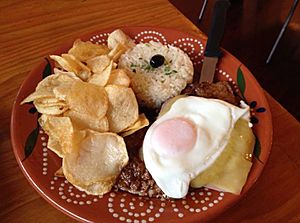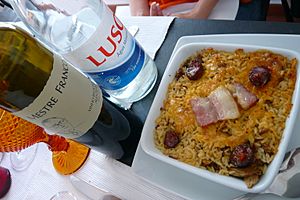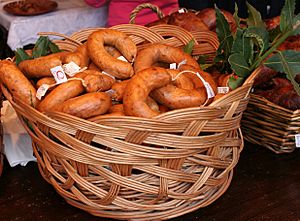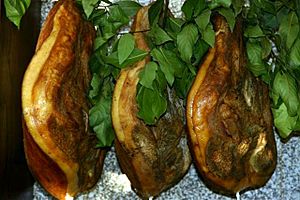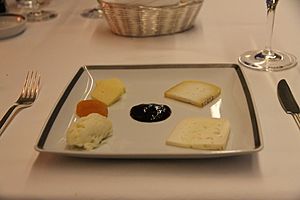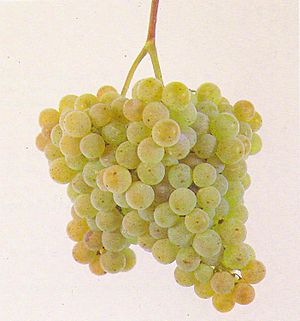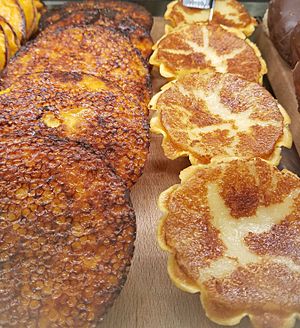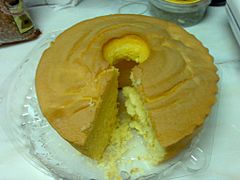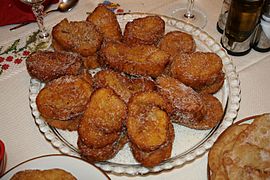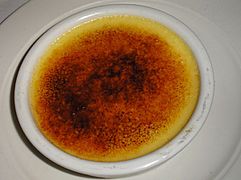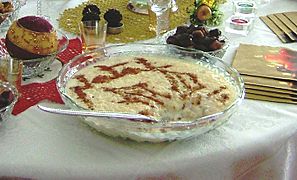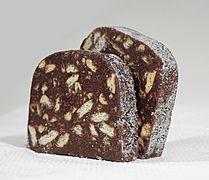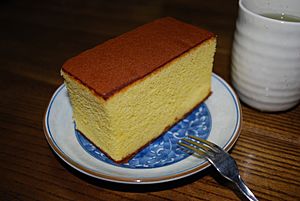Portuguese cuisine facts for kids
Portuguese food is famous around the world! The oldest known cookbook about it, called Livro de Cozinha da Infanta D. Maria de Portugal, was written in the 1500s. It describes many popular dishes with meat, fish, and poultry. Later, in 1936, António-Maria De Oliveira Bello, also known as Olleboma, published another important book called Culinária Portuguesa.
Portuguese cooking has strong influences from the Atlantic Ocean and the Mediterranean Sea. It also uses many spices from Portugal's history of trade with places like the East Indies, Africa, and the Americas. These spices include piri piri (small, hot chili peppers), black pepper, saffron, paprika, clove, allspice, cumin, cinnamon, and nutmeg. They are used in many savory dishes, especially in Continental Portugal, the Azores, and Madeira islands.
For desserts and some savory dishes, spices like cinnamon, vanilla, lemon zest, orange zest, aniseed, clove, and allspice are popular.
Garlic and onions are used a lot in Portuguese cooking. Many fresh herbs are also common, such as bay leaf, parsley, oregano, thyme, mint, marjoram, rosemary, and coriander.
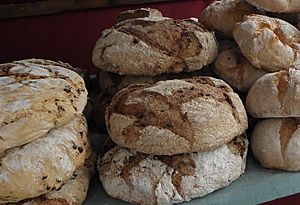
Olive oil is a key ingredient in Portuguese food. It is used for cooking and for adding flavor to meals. Portugal even has its own way of classifying olive oils based on how acidic they are. For example, extra virgin olive oil is great for drizzling over fish, potatoes, and vegetables.
Portuguese meals often include meats like pork, beef, and chicken. They also feature lots of seafood, such as fish, crabs, shrimp, octopus, and clams. Vegetables and beans are also important. For dessert, there are many delicious cakes and pastries. People often eat rice, potatoes, and bread with their meals. There are many kinds of traditional fresh breads, like broa. Portuguese and Galician cuisine (from Spain) share many similar traditions.
Contents
Food in the Middle Ages
During the Middle Ages, people in Portugal grew grains and beans for food. Fishing and hunting were also common. New ways to keep fish fresh were invented. Plants like grapevines and olive trees were also introduced. Bread made from rye or wheat was eaten widely during this time.
Daily Meals
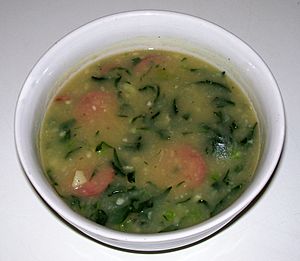
A Portuguese breakfast usually has fresh bread with butter, ham, cheese, or jam. People drink coffee, milk, tea, or hot chocolate with it. A small espresso coffee, sometimes called a bica, is very popular. People drink it at breakfast or after lunch, either at home or in cafés. Sweet pastries are also popular, as well as breakfast cereal with milk or yogurt and fruit. The famous Pastel de nata (custard tart) is a favorite for breakfast or an afternoon treat, often enjoyed with espresso.
Lunch often lasts over an hour and is served between noon and 2 PM. Dinner is usually around 8 PM. Both lunch and dinner often start with a soup. A common Portuguese soup is caldo verde. It is made from cooked and pureed potato, onion, and garlic. Shredded collard greens are added, and sometimes slices of chouriço (a smoked sausage).
Among fish dishes, salted cod (bacalhau) is very common. Popular desserts include pudim de ovos (caramel custard), mousse de chocolate (chocolate mousse), leite-creme (Crème brûlée), arroz doce (rice pudding with cinnamon), and tarte de maçã (apple tart). Portugal also has many kinds of cheese made from sheep, goat, or cow's milk. Famous cheeses include queijo da serra, Queijo São Jorge, and Requeijão.
Fish and Seafood Dishes
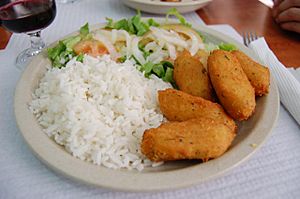
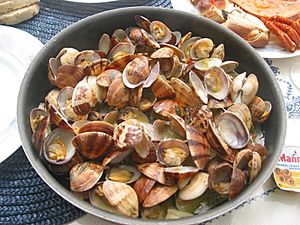
Portugal is a country by the sea, and its fishing industry is very important. This means people eat a lot of fish and seafood. Portugal eats more fish per person than any other country in Europe. Fish is cooked in many ways: grilled, boiled, fried, deep-fried, stewed, roasted, or steamed.
The most popular fish is bacalhau (cod). People say there are over 365 ways to cook cod, one for every day of the year! Cod is almost always used dried and salted. This tradition started before refrigerators were invented. So, before cooking, it needs to be soaked in water or sometimes milk. Simple fish dishes are often flavored with olive oil and white wine vinegar.
Portugal has been fishing and trading cod since the 1400s. Other popular seafoods include fresh sardines (especially sardinhas assadas), sea bass, swordfish, mackerel, octopus, squid, cuttlefish, crabs, shrimp, and lobster. Many other crustaceans and shellfish like clams and mussels are also eaten.
Caldeirada is a delicious stew made with different kinds of fish and shellfish. It also has potatoes, tomatoes, piri-piri, bell peppers, parsley, coriander, garlic, and onions.
River lamprey and eels are special fresh water foods. The Coimbra and Aveiro areas are known for their eel stews and seasonal lamprey dishes.
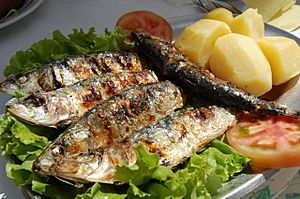
Sardines used to be preserved in salt water for sale in the countryside. Later, sardine canneries (factories that put food in cans) opened along the coast. Canned tuna is also widely available. Fresh tuna is usually eaten in Madeira and the Algarve. Canned sardines or tuna, served with boiled potatoes, black-eyed peas, collard greens, and hard-boiled eggs, make a quick meal.
Meat and Poultry Dishes
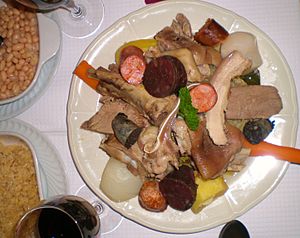
Eating meat and poultry every day used to be only for rich people. Pork and beef are the most common meats. A famous Portuguese dish, mostly eaten in winter, is cozido à portuguesa. It is a hearty stew that can include beef, pork, cured meats like chouriço, pig's feet, cured ham, potatoes, carrots, turnips, cabbage, and rice. This dish was originally a favorite of wealthy farmers.
Meat Dishes
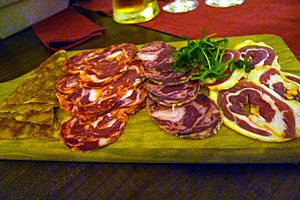
Tripas à moda do Porto (tripe with white beans) is a dish from the city of Porto. People from Porto are sometimes called tripeiros, meaning "tripe eaters." Another tripe dish is dobrada.
Today, the Porto region is also known for a toasted sandwich called a francesinha.
Many other meat dishes are popular. In the Bairrada area, Leitão à Bairrada (roasted suckling pig) is famous. Another dish, chanfana (goat cooked slowly in red wine), is claimed by two towns.
Carne de porco à alentejana, which is fried pork with clams, is a popular dish. It is believed to have been used in the Middle Ages to test if people who had converted from Judaism to Christianity were truly following their new faith. This was because it contained pork and shellfish, which are not kosher (allowed) in Jewish dietary laws.
The Portuguese steak, bife, is a slice of fried beef or pork. It is marinated in spices and served in a wine-based sauce with fried potatoes, rice, or salad. Sometimes, a sunny-side up egg is placed on top. This dish is then called bife com ovo a cavalo (steak with an egg on horseback).
Iscas (fried liver) was a favorite in old Lisbon taverns. Small beef or pork steaks in a roll (pregos or bifanas) are popular snacks. They are often served at beer halls with a large mug of beer. Espetada (meat on a skewer) is very popular in Madeira.
Cured Meats and Sausages
Alheira, a yellowish sausage from Trás-os-Montes, has an interesting history. In the late 1400s, King Manuel of Portugal ordered all Jewish people to become Christian or leave the country. Many Jewish people secretly kept their religion. To show they were good Christians, they created a sausage that looked like it was made with pork but actually contained game and chicken. Over time, pork was added to alheiras.
Chouriço or Chouriça is a distinct sausage. It is made with pork, fat, paprika, garlic, and salt. It is then smoked. There are many different kinds, varying in color, shape, spices, and taste. Many Portuguese dishes use chouriço, including cozido à portuguesa and feijoada.
Farinheira is another Portuguese smoked sausage. It uses wheat flour as a main ingredient. It is also used in traditional dishes like Cozido à Portuguesa.
Presunto (prosciutto ham) is a type of cured ham. The most famous presunto comes from the Chaves region. It is usually cut into thin slices or small pieces and eaten as a snack or added to dishes.
Portuguese cured meats and sausages (called charcutaria or enchidos) have a long history. They are prepared, seasoned, and preserved in many ways, like curing, salting, smoking, and drying.
Poultry Dishes

Poultry (birds like chickens and turkeys) was once considered a special food.
Chicken, duck, turkey, red-legged partridge, and quail are all part of Portuguese cooking. Popular dishes include frango no churrasco (chicken on the grill), chicken Piri Piri, Cabidela rice, Canja de galinha (chicken soup), and Arroz de Pato (duck rice).
Turkeys used to be eaten only for Christmas or special events. Today, they are available to everyone. Bifes de peru (turkey steaks) are now a common meal.
Vegetables and Starches
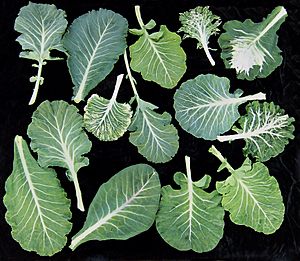
Popular vegetables in Portuguese cooking include many kinds of cabbage and collard greens, tomatoes, onions, and peas. There are many dishes with starchy foods. For example, feijoada is a rich black bean stew with beef and pork. Açorda is a Portuguese bread soup. Cozido stews often have kale, white beans, red beans, and fava beans. Pumpkins are used in soups and soufflés.
One vegetable and starch-rich soup is caldo à Lavrador. It is made with cabbage, red beans, potatoes, prosciutto chunks, and wheat flour.
Many dishes are served with salads. These salads are often made from tomato, lettuce, shredded carrots, and onion. They are usually seasoned with olive oil and vinegar. Potatoes and rice are also very common. Soups made from various vegetables, root vegetables, meats, and beans are widely available. Caldo verde is one of the most popular.
Fruits, Nuts, and Berries
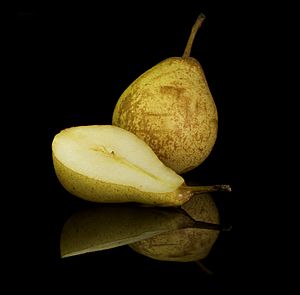
Before potatoes arrived from the New World, chestnuts were a main food during certain seasons. Now, chestnut dishes, desserts, and compotes are becoming popular again, especially in central and northern Portugal.
Other seasonal fruits, nuts, and berries are also part of the Portuguese diet. These include pears, apples, table grapes, plums, peaches, cherries, melons, watermelons, citrus fruits, figs, pomegranates, apricots, walnuts, pine nuts, almonds, hazelnuts, strawberries, raspberries, and blueberries. People eat them fresh or use them in desserts, marmalades, jellies, and liqueurs.
Cheese Varieties
Portugal has many kinds of cheeses. They are made from cow's, goat's, or sheep's milk. These cheeses usually have a very strong flavor and smell. Traditional Portuguese cooking does not often include cheese in recipes. So, cheese is usually eaten by itself before or after the main meal.
The Queijo da Serra da Estrela has a very strong flavor and can be eaten soft or more aged. It is handmade from fresh sheep's milk. In the Azores islands, Queijo São Jorge is a spicy cheese made from cow's milk. Other well-known cheeses include Queijo de Azeitão and Queijo de Castelo Branco.
Drinks and Beverages
Wines and Beers
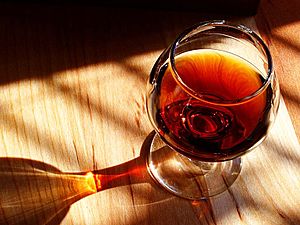
Wine (red, white, and "green") is the traditional Portuguese drink. Vinho verde, or "green" wine, is a special kind of wine from northwestern Portugal. It is called "green" because it needs to be drunk "young," not because of its color. Green wines are usually a little bit sparkling.
Port wine is a strong, sweet wine from the Douro River region. It is usually served with desserts. Alvarinho white wines from Minho are also very popular.
Vinho da Madeira is a regional wine made in Madeira. It is similar to sherry. From the leftover grapes after making wine, people make strong brandies called aguardente.
Typical liqueurs, like Licor Beirão and Ginjinha, are also very popular. In the south, especially the Algarve, a strong spirit called medronho is made from the fruit of the strawberry tree.
Beer was consumed in Portugal even before Roman times. The word for beer, ‘cerveja’, comes from an old Celtic word. Beer gardens, called Cervejaria in Portugal, are common everywhere. Lisbon even has a Beer Museum!
Pastries and Sweets
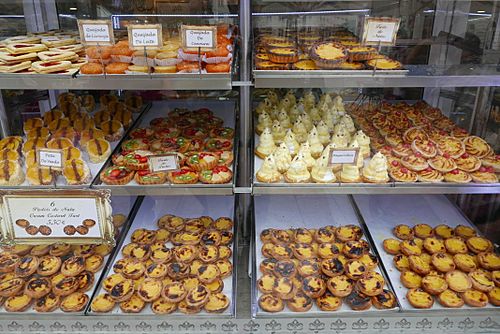
Portuguese sweets have had a big impact on cooking around the world. Many words like marmalade, caramel, and molasses come from Portuguese.
The Portuguese sponge cake called pão de ló is thought to be based on a 17th-century French recipe.
Probably the most famous Portuguese pastry is the pastel de nata. These custard tarts were first sold near the Jerónimos monastery in Lisbon in the early 1800s. Monks who lost their jobs after monasteries closed started selling them. The original pastry shop is still open today. This pastry is now famous worldwide and is sometimes called a "Portuguese custard tart." In 2011, the pastel de nata was voted one of the seven wonders of Portuguese food.
Many traditional Portuguese pastries were created in Middle Ages monasteries by nuns and monks. They sold these sweets to earn money. The names of these desserts often relate to monastic life, like barriga de freira (nun's belly) or papos d’anjo (angel's double chin). They are often called doçaria conventual (convent sweets). These recipes were kept secret and passed down through generations in the convents.
In Southern Portugal, you can find sweets influenced by the Al-Andalus region. These sweets use figs, almonds, and honey, like the colorful Algarve marzipan treats.
Most towns have a special local pastry, usually made with egg or cream. Examples include leite-creme (a type of Crème brûlée) and pudim flã.
Other popular pastries found in most cafés and bakeries are the Bola de Berlim (a type of doughnut), the Bolo de arroz (rice cake), and the Tentúgal pastries.
Doce de Chila/Gila is made from squash. Other sweets include wafer paper and candied egg threads called fios de ovos.
-
Leite-creme (Portuguese Crème brûlée)
-
Arroz Doce (Rice pudding)
-
Bola de Berlim (a type of Berliner)
-
Salame de Chocolate (Chocolate salami)
Portuguese Food Around the World
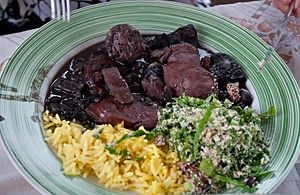
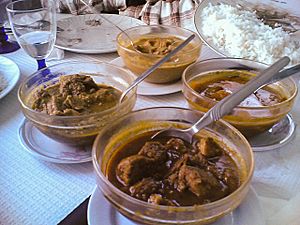
Portugal used to have a large empire, and its food has influenced many other cuisines. You can see Portuguese influences in Brazilian cuisine, with their own versions of dishes like feijoada and caldeirada (fish stew). Portuguese influences are also found in Macau (China) and places that were part of Portuguese India, like Goa. For example, vindalho (a spicy curry) shows the use of vinegar, chili pepper, and garlic.
Sweet oranges were brought from India to Europe in the 1400s by Portuguese traders. Before that, oranges in Europe were bitter. Some languages even named the orange after Portugal, because it was the main place they came from. For example, in Greek, orange is portokali.
The Portuguese also brought spices like cinnamon from Asia. Cinnamon is now used a lot in traditional Portuguese desserts and savory dishes.
The Portuguese "canja" (chicken soup with pasta or rice) is a popular food for sick people. It is similar to the Asian congee, which is used in the same way. This suggests it might have come from the East.
In 1543, Portuguese trade ships arrived in Japan. They introduced refined sugar, which was a luxury there. Japanese lords loved Portuguese sweets so much that they created their own versions. These included konpeitō (candy), kasutera (sponge cake), and keiran somen (the Japanese version of Portuguese "fios de ovos"). During this time, tempura (which looks like Portuguese peixinhos da horta) was also introduced to Japan by early Portuguese missionaries.
Tea became popular in England in the 1660s after King Charles II married the Portuguese princess Catherine of Braganza. She brought her love for tea, which came from the colony of Macau, to the English court. Queen Catherine also introduced marmalade to the English and made eating with a fork a common practice at court.
Portuguese immigrants around the world have also influenced local foods. For example, in Hawaii and parts of New England, pão doce (Portuguese sweet bread), malassadas, bean soup, and Portuguese sausages like linguiça and chouriço are eaten regularly.
In Australia and Canada, "Portuguese-style" chicken has become very popular. These dishes often use "Piri-piri sauce," a Portuguese sauce made with piri piri.
The Portuguese also had a big influence on African cuisine. They introduced corn to Africa. In turn, restaurants like Nando's (from South Africa) have helped spread Portuguese food worldwide.
Madeira Wine and Early American History
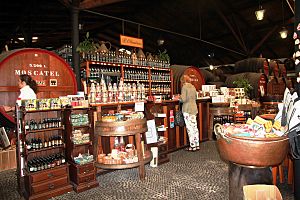
In the 1700s, Madeira wine became very popular in British North America. It was a luxury drink for wealthy European colonists. The price of Madeira wine increased a lot during this time. It was even used for a toast during the First Continental Congress in 1775.
Madeira wine was important in the history of the United States. Since good wine grapes could not be grown in the 13 colonies, they needed to import wine, and Madeira was a big part of that. One important event before the American Revolution involved Madeira wine. John Hancock's ship, the Liberty, was seized in 1768 by British officials. This happened after he unloaded a large amount of Madeira wine, and there was a disagreement about import taxes. This seizure caused riots in Boston.
Madeira wine was a favorite of Thomas Jefferson. It was used to toast the Declaration of Independence. Many important figures like George Washington, Betsy Ross, Alexander Hamilton, Benjamin Franklin, and John Adams also enjoyed Madeira. A bottle of Madeira was used to christen the USS Constitution in 1797.
See also
 In Spanish: Gastronomía de Portugal para niños
In Spanish: Gastronomía de Portugal para niños


